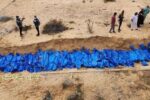Across Sudan, 45% of the population – around 21.2 million people – are facing high levels of acute food insecurity. The highest levels of malnutrition are centred on the besieged towns of El Fasher in North Darfur and Kadugli in South Kordofan.
However, 3.4 million fewer people are facing crisis levels of hunger compared to the December-May assessment. The joint analysis also showed that the food crisis is starkly divided along the lines of the conflict. In the areas where fighting has lessened, food security has increased due to humanitarian aid access.
Sudan famine: Besieged El Fasher and Kadugli starve
The Famine Review Committee (FRC) grades food access according to phases. In 2024, El Fasher and Kadugli were at the “Emergency” stage, Phase 4. However, they’ve now been moved up to Phase 5. This is due to the fact that they’ve now passed the famine threshold for key markers including food consumption, acute malnutrition and mortality.
It’s also highly likely that the conditions in Dilling mirror those in nearby Kadugli. However, the famine markers couldn’t be measured accurately because of the ongoing fighting in the area. Likewise, the FRC also projects a famine risk in 20 other areas across the Darfur and Kordofan regions.
Meanwhile, cases of malaria, cholera and measles are also rising in the areas where food and water infrastructure have collapsed. This is compounding the death toll among children and other vulnerable groups. UNICEF director of emergency operations Lucia Elmi explained:
The deadly combination of hunger, disease and displacement is placing millions of children at risk. Among them, girls often bear the brunt, facing increased risks of malnutrition, gender-based violence, and being pulled out of school. Therapeutic food, safe water, and essential medicines and health services can save lives, but only if we can reach children in time. We urgently need parties to abide by their obligations under international law and to provide humanitarian actors with safe, timely and unhindered access to children.
Funding and humanitarian aid are critical
At the same time, the fighting has eased in Khartoum, Al Jazirah and Sennar states since May of this year. Whilst this has meant that food access has improved, the danger is far from over. The war has eviscerated Sudan’s economy and damaged vital infrastructure.
Predictions also estimate that food stocks will run low by February of next year, should the war continue. Rein Paulsen, the FAO’s resilience director, said:
Despite the immense challenges, FAO and its partners remain committed to supporting communities wherever access allows. Seeds, tools and livestock are lifelines for millions of Sudanese farmers and herders. Restoring access and enabling local food production are essential to saving lives and protecting livelihoods.
The three aid agencies which conducted the analysis are prioritising the most affected regions for aid. This includes food, medicines, and agricultural and livestock support. However, all of that relies on aid workers being able to access the most critical locations. Wherever that is least possible, including El Fasher and Kadugli, people have had to live through months without consistent food or medical care.
Ross Smith, WFP’s director of emergencies, called for funding to help stop the spread of hunger and malnutrition:
WFP has made hard-won gains and is now reaching more than 4 million people each month with vital food assistance. We see what’s possible when we can deliver vital aid: families rebuild, markets revive, and children get the food they need to survive. But conflict still decides who eats and who does not. Too many communities are being pushed into starvation simply because we cannot reach them. We need additional funding and sustained, unhindered access — now — to stop famine from spreading.













